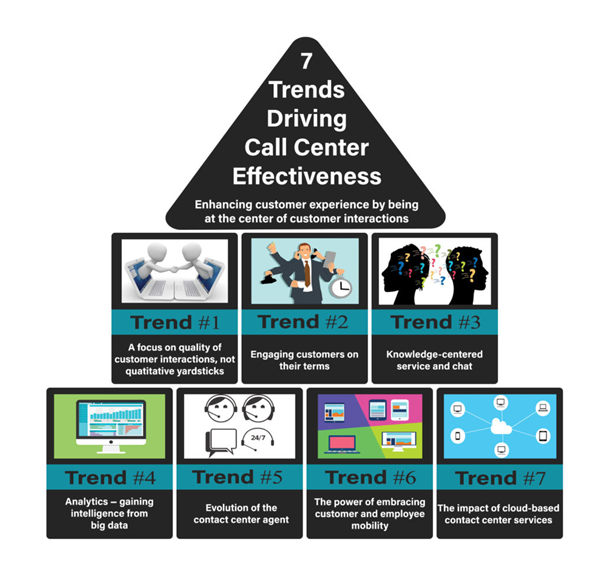The traditional call center has become obsolete. Organizations today need to reach their customers using the communications channels they want – while also cutting costs, improving agent efficiency, and maximizing the value of every customer.

Several years ago, Avaya released a study of seven trends in contact centers. Nearly ten years later, we review the past trends and predictions, compare that with where we are now to see how they panned out, as well as gain insight from industry experts on current trends and their thoughts on what we can expect in the future.
Trend #1. A focus on quality of customer interactions, not quantitative yardsticks
Then: Avaya pointed out that often basic metrics such as call length and number of calls are used to measure contact center performance, however these may not represent true success, with customer satisfaction being a more relevant indicator. For instance, often a longer call duration may be required to ensure the customer is pleased with the resolution, resulting in a smaller quantity of interactions. Avaya predicted that using qualitative metrics such as customer surveys may be a better determining factor of agent performance. Additionally, many customers are opting to use self-service IVRs and social media to resolve issues, increasing the need for additional analytics solutions that can collect and accurately report this valuable information.
Now: The term “customer experience” has replaced “customer service.” All industries are realizing just how important quality interactions are to customer retention and loyalty. Customer feedback and surveys provide crucial insight that helps organizations gauge customer success. And customers want to be heard. Microsoft reports that 89% of customers want the option to provide feedback. New technologies used in performance management software can zero in on information like call handle time, conversion rate, and on-hold rate, and provide valuable metrics. Voice of the Customer (VoC) tools allow consumers to communicate about their customer experience directly and provide intuitive data in customizable dashboards.
Takeaway: While traditional contact center stats such as Average Handling Time (AHT), call abandon rate, call containment rate, and zero out rate can help in measuring performance, gathering and analyzing customer feedback and satisfaction across all growing multiple channels is even more vital to ensure organizations are meeting their consumers’ expectations and needs.
Trend #2. Engaging customers on their terms

Then: “Newer communications channels, such as mobile apps, web, text, video, and social media, are growing rapidly while use of traditional voice channels is waning. This trend of consumers preferring new interaction channels over voice suggests that businesses could fall behind if they don’t respond.”
Now: Coined by Gartner as the ‘Everything Customer’ – today’s consumer wants and expects multi-experience options. Omnichannel contact center technologies have become increasingly widespread with chatbots, SMS texting, and social media. Microsoft reported that 66% of customers use an average of three communication channels to connect with customer service.
Still, even with all these evolving technologies, speaking to a live person is still the preferred method with a recent survey reporting that 76% of customers who contact customer service do so over the phone and 47% of all callers say they often skip right past an IVR and opt to speak with an agent live.
“Companies still need human representatives to handle the complexities of certain voice-interactions that cannot be satisfactorily synthesized and automated,” Chris Connolly, Vice President of Product Marketing at Genesys.
Takeaway: Providing customers with automated options is important and breakthroughs in conversational AI will continue to increase efficiency, but human-to-human interaction will never be fully replaced. The best solution is finding a balance – offering options while empowering agents with knowledge and skills for the best customer experience outcome.
Trend #3. Knowledge-centered service and chat
Then: “Customers have become active consumers of knowledge rather than simple parties to a transaction.” In the past a company’s website served as its primary knowledge base. But Avaya also stated that as chat is becoming used more and more, it is “changing the equation” by “enabling a collaborative knowledge-centric environment that has all the self-service environment while enabling a smooth client transition away from voice.”
Now: Chatbots are not only continuing to be utilized by more and more organizations in every industry but are becoming “smarter.” AI can pull data together, understand patterns of behavior, and identify the next best actions quickly.
“By implementing best practices for conversational AI, you’ll enable your contact center to increase sales, decrease time to resolution, and provide the best customer experiences possible. The balance of human interaction with data creates an enhanced experience for customers and agents, enabling a more conversationally relevant interaction every time fueling customer loyalty and delivering increased business results.” – Waterfield Technologies
Takeaway: AI technology is continuing to evolve and be incorporated more and more within the contact center. Expect this “trend” to become standard practice.
Trend #4. Analytics—gaining intelligence from big data

Then: “Using analytics will help you understand and match what your customers say versus the actual experience they have and determine how that aligns with your own statistics and benchmarks for what your company defines as a ‘great call experience.’”
Now: In the past, businesses mostly relied on internal data from contact centers and customer relationship management systems, but today’s advanced analytics can provide an even larger picture, if used correctly.
Takeaway: Companies that have applied advanced analytics using customer intelligence in their contact center have reported improved CSAT scores, increased revenue, and lowered operational costs. The key is to integrate the data properly across channels, using a single integrated platform, and most importantly, put those insights into action.
“Leading call-center organizations make their day-to-day decisions based on data, rather than gut instincts. Examples include analytically driven hiring, targeted coaching, performance-based bonuses, and other initiatives to improve outcomes.” – McKinsey
Trend #5. Evolution of the contact center agent
Then: Avaya pointed out that empowering contact center agents is important as consumers are becoming more tech-savvy than ever. “Most are adept at going online or using IVR systems to get the service they need from businesses without talking to a live agent. Although this reduces contact center call volume, it also means that customers who do request help from human attendants generally have more difficult issues to resolve and require agents who possess specialized knowledge. “
Now: Though ensuring an organization’s employees on the first line of contact are properly trained and equipped to assist the informed “everything customer” is undoubtedly crucial, there is overwhelming evidence to suggest this area is still continuously being overlooked. A recent study conducted by the Society of Workforce Planning Professionals found the average contact center turnover rate to be between 30-45%. Even more concerning, according to ICMI, 74% of customer service leaders acknowledge that they do not fully empower their agents to provide the best customer experience. On top of that, Forbes reports that around $75 billion is lost every year on poor customer service experiences.
Takeaway: An empowered customer experience agent is a major factor in customer retention/repeat business. As we learned in Trend #2, consumers still value human interaction and expect their frontline contact to be helpful, knowledgeable, and empathetic. Equipping customer success agents with the proper tools, training, and knowledge is key. Recent research proves that organizations need to view agents as an investment, not an expense.
“It is CRITICALLY IMPORTANT in today’s business environment to have your customer service operation recognized as a Profit Center and NOT as a Cost Center. Profit Centers are considered strategic within an organization and will experience increased investment, whereas Cost Centers are considered overhead and subject to cuts. – Jim Lagger, Contact Center Specialist
Trend #6. The power of embracing customer and employee mobility

Then: “Consumers are driving the ‘channel of choice’ for many customer-facing functions, such as purchasing and support, so organizations risk losing customers by sticking with traditional channels.”
Now: Not surprisingly, more and more customers are using their mobile devices than ever. According to a CFI Group study, in 2019, more customers accessed a company website using their mobile device (48%) than a laptop (40%) , desktop (39%), or tablet (12%). And before contacting customer service, 64% of customers said they have tried solving their issue online or through a company app.
Takeaway: Mobile-enhanced websites and apps with self-service options are as crucial now as having a company website.
Trend #7. The impact of cloud-based contact center services
Then: As of the time of the original article, cloud-based anything was still a relatively new concept. While the Avaya study pointed out that cloud-based architectures can make it easier to extend personalized services, it was recommended that organizations assess whether a cloud solution is the most efficient for the organization versus an on-premise solution fiscally.
Now: Covid-19 played a large part in many organizations’ move to cloud-based technology, as 43 percent of businesses accelerated their cloud transformation as a result of the pandemic. Research from Contact Center Week (CCW) shows that only 7% of companies anticipate returning to a “traditional” contact center model post-pandemic. Remote and/or hybrid models have become the standard for millions of distributed agents worldwide as research estimates that more than 50% of organizations will have moved their contact center solution to the cloud by the end of 2021. It’s easy to see why. According to a recent study, cloud contact centers are 27% less expensive and experience 35% less downtime than their on-premise counterparts. Plus, the outdated technology used in legacy contact centers often cannot support things like social media, mobile app chats, and videos, which have become essential. The cloud-based contact center market is predicted to reach 56.37 billion by 2028.
Takeaway: Cloud is no longer a future option; it is a present must. Cloud-based contact centers can help companies meet the demands of today’s customer by supporting newer technologies and are more readily available and cost-effective than ever, with customizable options for every size contact center.
Altura Communication Solutions can help you with your contact center evolution. From internal operations to customer relationship management, we offer solutions using the latest technology to help make your entire contact center more effective. Altura has long been recognized as a leader in call center/contact center solutions and, as one of the largest Avaya Business Partners, Altura brings the advantages of this world-class contact center expertise to your organization. Speak to a specialist today.





Comments are closed.